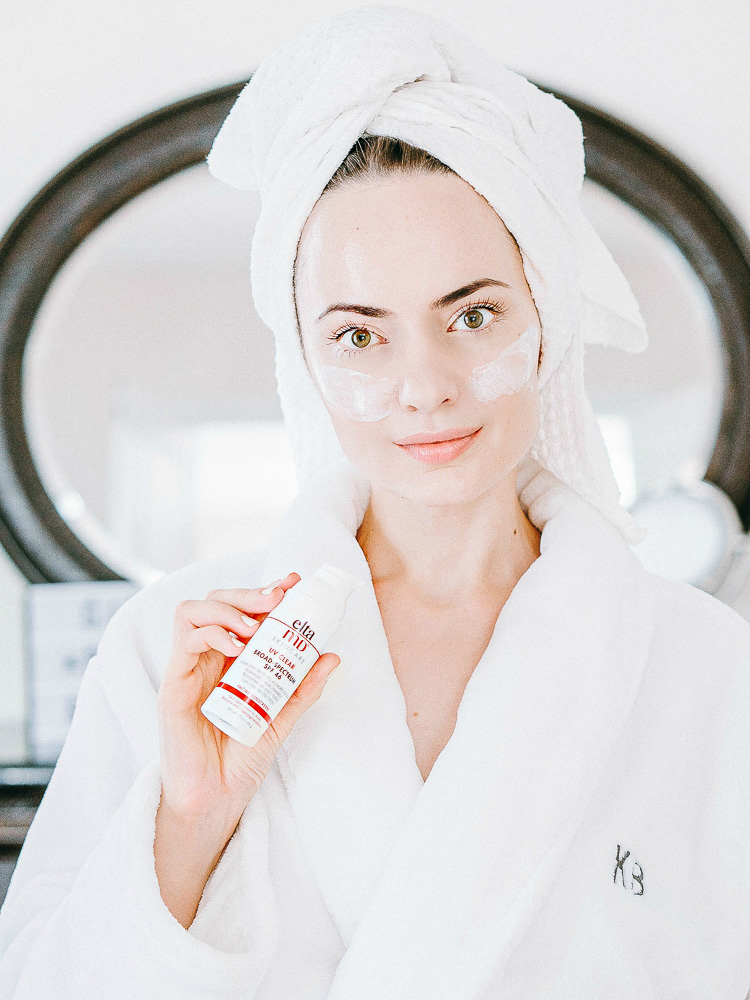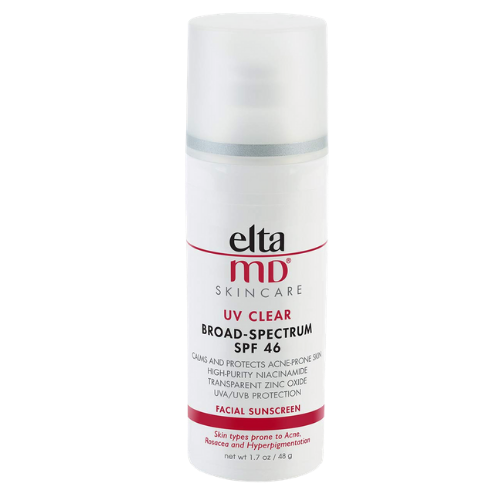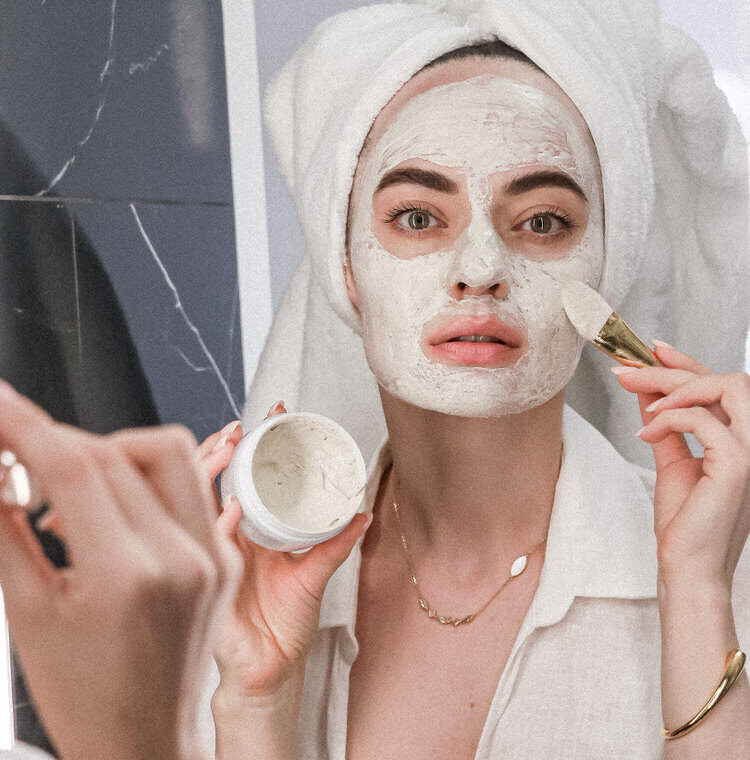
As s pale girl, I take the topic of sun protection very seriously. Meaning: there is no day in a year when I’m going without SPF. Today, we are diving into the reasons why sunscreen should always be the last step of your AM skincare routine. Also, we will dive into the dilemma of mineral vs chemical sunscreen — what’s the difference and which formula to pick for your skin type.
Why Sunscreen Matters
There are so many reasons why wearing sunscreen is essential. But since it’s a beauty, not a medical blog, let’s stick to the skincare aspect of it. Below, I provide the reasons why sunscreen is essential — from skincare standpoint. No mentioning of scary things like skin cancer etc. Promise!
Sunscreen protects your skin from sunburn.
With repeated sun damage, the skin starts to look dry and wrinkled. With excessive sun exposure, all sorts of discolorations and rough patches appear that don’t look cute. In other words, too much sun weakens your skin, and it ends up looking less presentable.
Sunscreen is your go-to anti-aging tool.
If you are with me on getting regular Botox injections, sunscreen should be the first step in your anti-aging game. In a way, a proper sunscreen routine is your ticket to slowing down the development of wrinkles and fine lines.
A recent study concludes that daily use of a broad-spectrum sunscreen (i.e., a product that protects from both UVA and UVB damage) “slows skin aging, even in middle-aged men and women.” That study observed 900 men and women from Australia over four years, and the results were impressive: daily sunscreen users were less likely to have wrinkles and dark spots than participants who did not wear SPF.
Sunscreen helps to keep your skin tone even.
Skin discolorations and uneven skin tone are two most-asked questions on the blog — and these are connected to using sunscreen. Or, should I say, the discoloration issues could be avoided with a proper sunscreen routine.
Dark spots (also known as age spots, liver spots, or wisdom spots) are skin’s direct response to UV radiation. This means that if you already have them, you probably didn’t do a great job with protecting your skin from the sun.
The good news is that it’s never late to start using sunscreen. You might need additional procedures and products to reverse the damaging effect of the sun, but at least you will not get new sunspots if you start using sunscreen regularly.

The ABCs of SPF: Mineral vs Chemical Sunscreen
Now, when we are on the same page on the importance of using sunscreen, let’s dive into types of sunscreens. Generally speaking, there are two types of sunscreens. Those that contain mineral ingredients (aka physical sunscreens) and synthetic ones (aka chemical sunscreens). Here is a skinny on which sunscreen type is right for you.
Mineral Sunscreens
Mineral, aka physical sunscreen group, consists of only two ingredients: zinc oxide and titanium dioxide. That type of sun protecting ingredients work as a light reflector — so damaging sun rays do not penetrate your skin.
Mineral sunscreens start to work immediately after application and need more considerate application. In other words, it’s essential not to miss a spot while applying a mineral sunscreen onto the skin.
If you have acne-prone skin with tendencies to sensitivity (like mine!), mineral sunscreens are the best option to choose from. There is no evidence that mineral sunscreens cause allergic reactions. Zinc oxide paste is used to treat skin irritations such as burns, cuts, and even diaper rash. So, if babies are not allergic to this ingredient, most likely, you will not be either.

The mineral sunscreen option I recommend is Elta MD UV Clear Broad-Spectrum SPF 46. The oil-free formula provides not only protection from damaging effects of the sun but also works for acne-prone skin.
Zinc oxide featured in this formula ensures that your skin receives the proper level of protection from a potential sunburn. The formula also helps to calm down the skin prone to irritations and breakouts.
There are two options to choose from: clear and tinted. Both are creamy and easy to apply, do not move your makeup, and do not cause any irritations. If you are just starting with wearing sunscreen regularly, that’s a great option, to begin with. It’s an industry’s favorite sunscreen brand.
Chemical Sunscreens
Synthetic, aka chemical sunscreens, are a bigger group that consists of over 30 ingredients. These work by absorbing into the top layers of skin and acting in one out of two possible ways: (1) attracting and bouncing the harmful sun rays, or (2) transforming and “deactivating” UV rays. The most common synthetic sunscreen ingredients include octinoxate, oxybenzone, and avobenzone.
These ingredients absorb deeper into the skin than mineral sunscreens and feature a formula that allows incorporating additional skincare ingredients into the product. Since such products work on a deeper level, there is less concern about applying chemical sunscreens precisely.
Synthetic sunscreens tend to have a lighter formula, so you will most likely find those in makeup products like foundations with SPF and sunscreen-enhanced primers.
These days, a lot of brands opt-in for a combination sunscreen formula. For instance, the mentioned above Elta MD sunscreens feature both mineral and synthetic ingredients.
Such formulation not only makes the product more versatile when it comes to the sun protection but also allows to incorporate extra ingredients into the formula. For instance, niacinamide (aka Vitamin B3, one of the best anti-aging ingredients) and Lactic Acid (helps reduce acne breakouts).

The SPF Number Game
When it comes to sunscreens, it’s always a number game, right? Over the past years, brands seem to move away from your typical SPF 30 and impress the public with SPF 50, 70, and even 100. Does it matter though what your SPF bottle number say?
Yes and no. In a nutshell, you want your sunscreen to protect you long enough, so you don’t need to re-apply sunscreen every hour. But you don’t want to get into the inflated SPF numbers. Often higher SPF means more ingredients and thus a higher risk for skin irritations.
I prefer sticking to somewhere between SPF 30 and 50 in my skincare routine. And if my makeup face product features an additional SPF 15 to 30, it’s just a bonus — but not even nearly enough for all-day protection.
I found a fascinating article in The Atlantic calculating how long different SPF numbers protect your skin from the sun. The author claims that SPF 80 improves SPF 30 protection just a tiny bit, so there is no need to upgrading your sunscreen numbers. In a way, anything above SPF 50 is a marketing trick. When it comes to SPF, bigger is not always better — and that’s what I also believe in.
* * * * *
There you have it: my two cents on sunscreens and sun protection. I hope this breakdown answered some of the questions that you might have about SPF. Please let me know in the comments if you have any additional questions or concerns.






